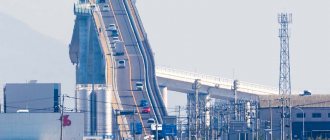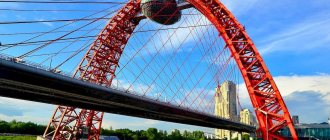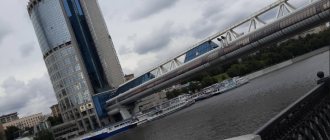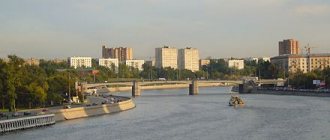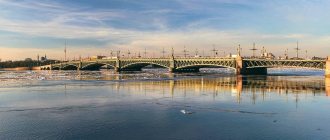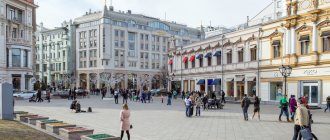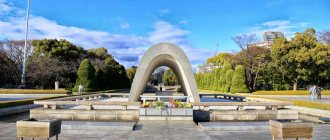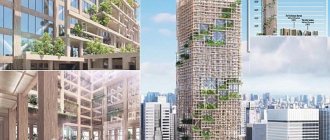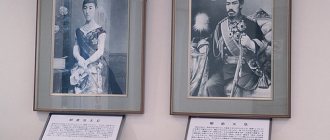Akashi Kaikyo Suspension Bridge
is a steel suspended system with a three-span, double-hinged stiffener beam. The height of the steel lattice pylons reaches almost 282.8 m.
The bridge is designed for 6-lane high-speed traffic and is designed to withstand heavy wind loads (an average of 80 m/s for 10 minutes) and 8.5-point (on the Richter scale) seismic impact.
Akashi-Kaikyo Suspension Bridge (akashi kaikyo) – stroyone.com
Akashi-Kaikyo Suspension Bridge Records
The cost of constructing the bridge was 500 billion yen. The Akashi-Kaikyo Suspension Bridge has twice entered the Guinness Book of Records:
- as the longest suspension (suspension) bridge until March 2017
- the new record belongs to the Canakkale 1915 Bridge suspension bridge
- and as the highest bridge, since its pylons rise to 298.3 m, which is higher than a ninety-story building.
- And one more interesting fact: if all the steel cables of the Akashi-Kaike Bridge were stretched out in length, they could encircle the Earth seven times!
Sky Bridge on Langkawi Island
Image: Wikimedia Commons
- Location: Langkawi Island, Kedah, Malaysia.
- What is different: length - 125 meters, height above the ground - 100 meters. The bridge is suspended by steel cables on a single support.
- What is it built from: steel, concrete and glass panels.
The Langkawi Bridge was built by 1. B. Barr, Thomas Telford. Fourth International Conference on Current and Future Trends in Bridge Design, Construction and Maintenance 2. Langkawi Sky Bridge / Langkawi Insight 3. SkyBridge / Panorama Langkawi so that tourists from all over the world can enjoy the magnificent view of the island called the pearl of Kedah.
This structure is the island's signature structure and is also the world's longest single-support bridge.
To build the Sky Bridge, sections of it had to be lifted up the mountain by helicopter. The structure was created in 12 months and opened in February 2005. The bridge has been rebuilt several times. First, a viewing platform was attached to it. Then they added a lifting cabin so that they didn’t have to walk up the mountain. And then they added glass inserts so that tourists could see the jungle below.
The weather on the island is very humid and there are often thick fogs. If walking across the bridge on a sunny day is boring for you, visit Langkawi on a cloudy day, when you can hardly see your own outstretched hand in the haze. Thrills are guaranteed.
Parameters of Akashi Kaikyo Suspension Bridge
| No. | Main technical parameters of the suspension bridge |
| 1 | Bridge layout: 960 + 1991+ 960 m. |
| 2 | The total length of the suspension bridge is 3911 m. |
| 3 | The length of the central channel span is 1991 m |
| 4 | The total width of the span is 35.5 m |
| 5 | The height of the pylons is 282.8 m |
| 6 | The height of the beam (span) is 14 m |
| 7 | Underbridge clearance (clearance) - 65.72 m |
| 8 | Number of lanes - 6 |
| 9 | The cost of the bridge is 3.6 billion dollars. |
| 10 | Location -34.6162°N 135.0205°E |
| 11 |
|
| 12 | Opening of the bridge - April 5, 1998 |
The history of the suspension bridge
Before this bridge was built, there was a ferry service across the Akashi Strait. This dangerous waterway was often subject to severe storms. In 1955, two ferries sank during a storm, killing 168 children. Resident unrest and general discontent forced the Japanese government to draw up plans to build a suspension bridge.
Initially, it was planned to build a railway-road bridge, but in April 1986, when construction of the bridge began, it was decided to limit traffic to 6 lanes only. In fact, the construction of the bridge began in 1988, and the opening took place on April 5, 1998. The Akashi Strait is an international waterway and must be at least 1,500 meters wide.
The Akashi Kaikyo Suspension Bridge has three spans; the central one is 1991 meters long and two sections are 960 meters long. The total length of the bridge is 3911 meters. The length of the main span was originally planned to be 1,990 meters, but it was increased by one meter after the Kobe earthquake on January 17, 1995.
The design of the suspension bridge has a system of double-hinged stiffening beams, which allows it to withstand wind speeds of up to 80 meters per second, seismic activity of up to 8.5 on the Richter scale and resist sea currents.
Construction of the bridge began in March 1988 in difficult conditions of the sea strait with a maximum depth along the bridge route of 110 m, a current speed of 4.5 m/s and a shipping intensity of 1,400 vessels/day, not counting the fishing fleet.
The structures of the pylon foundations and anchor abutment described below are designed, respectively, for a vertical load of 1 GN (100 thousand tf) and a cable tension force of 1.2 GN (120 thousand tf).
While the western (Awaji side) anchor abutment of the Akashi-Kaike Bridge rests directly on a granite foundation, the eastern (Kobe side) foundation is a cylindrical concrete mass with an outer diameter of 85 m and a height of 64.5 m. buried in bedrock (Pliocene sandstone and shale), lying at a depth of 55 m under a layer of sandy gravel soil.
Cable car in Kakum National Park
Image: Wikimedia Commons
- Location: Kakum National Park, Ghana, West Africa.
- What is different: length - 330 meters, height above the ground - 40 meters. The road is attached to nearby trees.
- What is it built from: wood and ropes.
In general, such suspended roads are not uncommon in many countries of the world, but in Africa there is only one of these per continent. It is located Canopu Walkway/Kakum National Park in Kakum National Park. The path is suspended on ropes, and its supports are tree trunks. It consists of seven bridges.
From the walking path you can see the beautiful rainforest and see elephants, buffalos and leopards in their natural habitat. The main thing is not to fall in with them, because this is exactly the kind of acquaintance that should be avoided.
Construction of the suspension bridge foundation
- construction of an external enclosing lintel with a thickness of 2.2 m and a depth of 75.5 m using the “wall in soil” method;
- development of a cylindrical pit within the external fence with the subsequent construction of an internal reinforced concrete wall 2 m thick;
- laying a 4 m thick concrete pad and a 2.5 m thick structural bottom along the bottom of the pit;
- filling the cylindrical chamber with concrete;
- concreting of a 6 m thick structural outer slab.
The construction of a fence of such a scale from special high-strength concrete using the “wall in soil” method was unprecedented in world practice and was carried out as follows.
- Initially, the wall was divided into 46 sections, half of which were restrictive sections 8510 mm long, developed into three grips, and the second half connecting single grip sections 3200 mm long.
- The development of the grips was carried out by three drilling units equipped with milling heads: two of the “hydraulic cutter” type, model NR-10000M
- one of the “electric mill” type, model EM 320 M.
The cutting tools of these units made it possible, in the process of developing connecting grips, to drill out the ends of the restrictive sections of the day to ensure an oblique interface between them with waterproof seams.
Upon completion of drilling the next section of the trench, the bottom sludge was removed, the entire volume of the suspension in the trench was replaced by fresh clay solution by pumping, a reinforcement frame spliced from four integrally transportable sections 18 m high was lowered into the trench, and the laying of the concrete mixture began.
In the restrictive sections, 4 concrete pipes with a diameter of 250 mm were used, in the connecting sections - two. The concrete mixture was delivered in concrete mixer trucks; 1336 m3 of mixture was required for each restrictive section of the fence, and 510 m3 for each connecting section. The total volume of concrete for the construction of the fence was 44.5 thousand m3
Under the protection of the fence, the soil was excavated with excavators to a depth of 61 m from sea level and an internal wall 2 m thick was erected, structurally combined with the fence
Each of the 12 sections of this wall, 4.5 m high, was concreted after the development of the corresponding tier of the pit. The total volume of concrete mixture for the construction of the internal wall was 24.9 thousand m3.
A concrete pad 4 m thick was made of special concrete, and first its central part was laid by rolling the mixture with vibrating rollers, and then the annular peripheral part, working together with the enclosing wall, was concreted using conventional technology using submersible vibrators. The volume of compacted concrete was 16.5 thousand m3 of the outer ring - 1.2 thousand m3 of the bottom structural slab concreted on top of the cushion - 12 thousand m3
The chamber space (with an internal diameter of 76.6 m and a height of 51 m), formed by a cylindrical fence and a bottom, was filled with a concrete mixture compacted by vibrating rollers.
This technology minimizes the thermal stresses that develop during cement hydration. Like the cushion, the 1.5 m wide outer ring was concreted using traditional technology using deep vibrators. The volume of work on compacted concrete amounted to 216.1 thousand m3; the annular part was 18.2 thousand m3.
After filling the chamber with concrete, a reinforced concrete top slab 6 m thick and 80.6 m in diameter was concreted on its upper edge in two steps (in semicircles). Laying was carried out in four layers 1.5 m thick, and in the upper layer a special low-exothermic super-mobile (not requiring vibration compaction) concrete mixture.
The total volume of concrete on the top slab was 32.6 thousand m3. Thus, for various foundation elements of the anchor abutment of the Akashi-Kaike Bridge, concrete mixtures of several special formulations were required with a water-cement ratio ranging from 0.33 to 0.77, and a design concrete strength ranging from 90 to 300 kgf/cm2 (9- 37 MPa). The volume of concrete mixture was about 550 thousand m3, and according to the technology, in some cases it was necessary to lay up to 6 thousand mixtures in one working day. At the same time, the climatic conditions of the facility required artificial cooling of the mixture.
To master such a volume of work, a stationary concrete plant with a maximum technical productivity of 480 m3/h was equipped at the site, including the following components: - mixers (forced action with hydraulic drive, biaxial adjustable) - 2 × 6 m3; — feeders: for aggregates (belt) — 3×1200 t/h, for cement (pneumatic) — 2×70 t/h; — dispensers:
- sand - 1×700 kg,
- crushed stone - 2×6000 kg,
- cement - 1×2850 kg and 1×1000 kg,
- water – 1×1200 kg, additives – 1×40 kg
- and 1×15 kg, ice - 1×550 kg,
- additives for subsequent administration - 2x25 kg and 1x15 kg;
- a berth for unloading bulk cargo from ships with two 50 m bins and six belt conveyors with a capacity of 600 t/h and a pneumatic cement unloader with a capacity of 200 t/h;
bins for materials with a capacity of:
- for sand - 4×1000 m3,
- for crushed stone - 4×1130 m3,
- for cement - 1x1500 t, for additives - 4x10 m3 and 1x4 m3
- for water - 1×246 m3;
- working bins of the dosing unit:
- for sand - 2×125 m3
- for crushed stone - 2×125 m3
- for cement – 1×70 m3 and 1×40 m3 for water – 1×4 m3
The concrete farm also included:
- ice making plant with a capacity of 60 tons per day with an ice storage tank of 100 tons;
- water cooling unit - 1×180 thousand kcal/h, s
- cold water tank with a capacity of 20 m3;
- concrete mixer cleaning station - for simultaneous processing of three drums;
- installation for regeneration of aggregates from waste concrete mixture with a capacity of 6 m3/h;
- installation for purification of contaminated water with a capacity of 10 m3/h;
- laboratory with a useful area of 145 m3 (designed for simultaneous storage of 1200 standard samples).
Walking path "Writhing Dragon"
Image: SIHASAKPRACHUM / Shutterstock
- Location: Zhangjiajie, Tianmen Mountain, China.
- What is different: length - 100 meters, height above the valley - 430 meters. The valley itself is another 300 meters deep.
- What it's built from: 99 winding sections of tempered glass that could have been stronger.
In addition to the above-mentioned bridge, there is much more to see in Zhangjiajie Park. For example, on the “Writhing Dragon” walking path, which encircles Tianmen Mountain. What is the track like? Nothing special, just the glass from which it is made tends to crack under the feet of passers-by.
The "Writhing Dragon" became famous thanks to a viral video of a frightened Chinese tourist whose glass cracked underneath him.
The park administration claims that this is a special effect: to add to the thrill, engineers specially install safe, but at the same time creaking and cracking panels on the path. Good excuse, yes.
